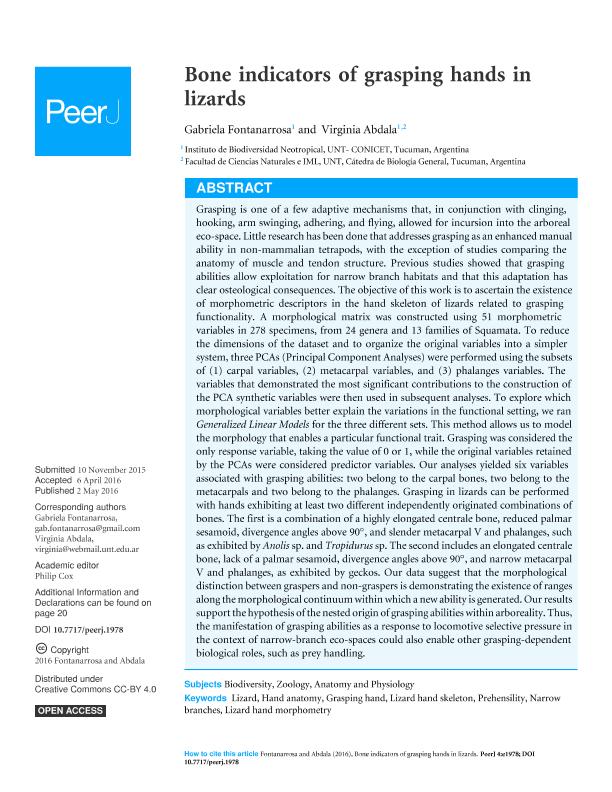Mostrar el registro sencillo del ítem
dc.contributor.author
Fontanarrosa, Gabriela

dc.contributor.author
Abdala, Virginia Sara Luz

dc.date.available
2018-10-11T17:21:08Z
dc.date.issued
2016-05
dc.identifier.citation
Fontanarrosa, Gabriela; Abdala, Virginia Sara Luz; Bone indicators of grasping hands in lizards; PeerJ; PeerJ; 1978; 5-2016; 1-28
dc.identifier.issn
2376-5992
dc.identifier.uri
http://hdl.handle.net/11336/62216
dc.description.abstract
Grasping is one of a few adaptive mechanisms that, in conjunction with clinging, hooking, arm swinging, adhering, and flying, allowed for incursion into the arboreal eco-space. Little research has been done that addresses grasping as an enhanced manual ability in non-mammalian tetrapods, with the exception of studies comparing the anatomy of muscle and tendon structure. Previous studies showed that grasping abilities allow exploitation for narrow branch habitats and that this adaptation has clear osteological consequences. The objective of this work is to ascertain the existence of morphometric descriptors in the hand skeleton of lizards related to grasping functionality. A morphological matrix was constructed using 51 morphometric variables in 278 specimens, from 24 genera and 13 families of Squamata. To reduce the dimensions of the dataset and to organize the original variables into a simpler system, three PCAs (Principal Component Analyses) were performed using the subsets of (1) carpal variables, (2) metacarpal variables, and (3) phalanges variables. The variables that demonstrated the most significant contributions to the construction of the PCA synthetic variables were then used in subsequent analyses. To explore which morphological variables better explain the variations in the functional setting, we ran Generalized Linear Models for the three different sets. This method allows us to model the morphology that enables a particular functional trait. Grasping was considered the only response variable, taking the value of 0 or 1, while the original variables retained by the PCAs were considered predictor variables. Our analyses yielded six variables associated with grasping abilities: two belong to the carpal bones, two belong to the metacarpals and two belong to the phalanges. Grasping in lizards can be performed with hands exhibiting at least two different independently originated combinations of bones. The first is a combination of a highly elongated centrale bone, reduced palmar sesamoid, divergence angles above 90°, and slender metacarpal V and phalanges, such as exhibited by Anolis sp. and Tropidurus sp. The second includes an elongated centrale bone, lack of a palmar sesamoid, divergence angles above 90°, and narrow metacarpal V and phalanges, as exhibited by geckos. Our data suggest that the morphological distinction between graspers and non-graspers is demonstrating the existence of ranges along the morphological continuum within which a new ability is generated. Our results support the hypothesis of the nested origin of grasping abilities within arboreality. Thus, the manifestation of grasping abilities as a response to locomotive selective pressure in the context of narrow-branch eco-spaces could also enable other grasping-dependent biological roles, such as prey handling.
dc.format
application/pdf
dc.language.iso
eng
dc.publisher
PeerJ
dc.rights
info:eu-repo/semantics/openAccess
dc.rights.uri
https://creativecommons.org/licenses/by-nc-sa/2.5/ar/
dc.subject
Grasping
dc.subject
Hands
dc.subject
Lizards
dc.subject
Glms
dc.subject.classification
Otras Ciencias Biológicas

dc.subject.classification
Ciencias Biológicas

dc.subject.classification
CIENCIAS NATURALES Y EXACTAS

dc.title
Bone indicators of grasping hands in lizards
dc.type
info:eu-repo/semantics/article
dc.type
info:ar-repo/semantics/artículo
dc.type
info:eu-repo/semantics/publishedVersion
dc.date.updated
2018-10-09T20:34:29Z
dc.journal.number
1978
dc.journal.pagination
1-28
dc.journal.pais
Estados Unidos

dc.journal.ciudad
Nueva York
dc.description.fil
Fil: Fontanarrosa, Gabriela. Consejo Nacional de Investigaciones Científicas y Técnicas. Centro Científico Tecnológico Conicet - Tucuman. Instituto de Biodiversidad Neotropical. Universidad Nacional de Tucuman. Facultad de Ciencias Naturales e Instituto Miguel Lillo. Instituto de Biodiversidad Neotropical. Instituto de Biodiversidad Neotropical; Argentina
dc.description.fil
Fil: Abdala, Virginia Sara Luz. Universidad Nacional de Tucumán. Facultad de Ciencias Naturales e Instituto Miguel Lillo. Cátedra de Biología General; Argentina. Consejo Nacional de Investigaciones Científicas y Técnicas. Centro Científico Tecnológico Conicet - Tucuman. Instituto de Biodiversidad Neotropical. Universidad Nacional de Tucuman. Facultad de Ciencias Naturales e Instituto Miguel Lillo. Instituto de Biodiversidad Neotropical. Instituto de Biodiversidad Neotropical; Argentina
dc.journal.title
PeerJ
dc.relation.alternativeid
info:eu-repo/semantics/altIdentifier/doi/http://dx.doi.org/10.7717/peerj.1978
dc.relation.alternativeid
info:eu-repo/semantics/altIdentifier/url/https://peerj.com/articles/1978/
Archivos asociados
